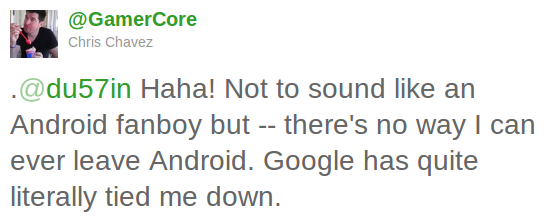
Over the past two years, I have extensively used all of the popular mobile operating systems here in the States. Each platform has unique benefits which cause me to love each and every one in their own way. BlackBerry has BBM, topnotch email and excellent battery life; iOS has an endless supply of apps and one of the best software keyboards; webOS has superior multitasking and unobtrusive notifications; and Windows Phone 7 has a “no nonsense” air to it.
With such a diverse selection, I like to switch it up from time to time. Popping the SIM card into a new device on a totally different platform can be fun and refreshing. But of all the platforms, I find myself having a hard time taking a break from one in particular: Android. It's full of bugs and glitches, the devices and users are plagued with fragmentation and battery life is generally a joke. Android devices are usually irrelevant by the time they finally make it to shelves and you're never really sure when official updates will hit.
Despite all of its gaping flaws, I can't leave. Since I started with Android back in 2009 with the CDMA HTC Hero, I have not totally left the platform. Not for a week. Not for a day. I have had an active Android phone on one of my lines since 2009 without break. Why can't I leave? Google has me tied – tied up in all of their services that are either completely absent or inferior on other platforms.
This is the number one reason for always keeping a connected Android device nearby. Even though I moved here two years ago, I'm still new to the Charlotte metro area and do not know my way around very well. Being a nice brother, though, I gave my GPS to my sister (who had just moved to a new city) after buying my first Android phone. Little did I know I would break into the tech journalism industry and switch phones more than I change my underwear (not really …) and need a reliable GPS again.
There are always third-party navigation services that add a monthly charge to your bill. But knowing Google offers the service for free, I can't force myself to pay for the carrier's service, especially after seeing how the two compare. I've tried them all and I prefer the native Android feature.
There are a handful of alternatives to Google's Music Beta. Cloud streaming services are all the rage in 2011, but after spending almost an entire week uploading my music to Google's servers, I don't want to have to sit through that again. And Google's service is seamless – perfectly streamlined with the Android experience.
I do pay $9.99 per month for Spotify to stream practically whatever music I want, so an additional cloud music service should not be required. But I've been using Spotify for two months now and I'm running into more and more music and artists – like Red Hot Chili Peppers and Despised Icon, two that I've severely missed listening to – that are not available due to licensing fees. Having a free secondary service with all of my music available at all times (without taking up precious SD card space), and being able to listen to the missing artists on Spotify, is extremely convenient.
I'm going to catch flak for this one, I just know it. Google launched their second attempt in the social media realm just months ago and it has spread like wildfire. Initially, the Google+ app was only available on Android. After a month of torture, the iPhone app was approved.
I have used both applications extensively and surprisingly found the Android app to be more enjoyable to use. The iOS app does have one leg-up on the Android app: the notification page has the “pull to refresh” feature. But the Android app has one key feature that the iOS app can't hold a candle to: Instant Upload. Every picture I take with my phone automatically gets uploaded to a private album on my Google+ account. Also, when I sign in and enable Google plus from an Android phone, all of my Google+ photos are available for local viewing in the Gallery app.
This portion is debatable, but for simple “at a glance” items like weather and agendas, I don't want to have to open an app or drop a notification bar down. I simply glance at the home screen and I have the information I need to know. It's quick and only makes sense.
Lastly, I use Google Apps religiously. Contact sync, Gmail, Calendar, Docs, Music and more are offered natively through account setup in Android settings. Most of these can be viewed or enabled on another platform, but they are not nearly as streamlined as they are on an Android device. Syncing my Google contacts through a BIS (BlackBerry Internet Service) doesn't always show all contacts – those I've manually entered and those I've only contacted or “recents.” And I've found much of the same on iOS.

I may not always have to carry an Android phone as my primary, but like Chris, I find it impossibly hard to completely leave Android behind, no matter how crazy it makes me at times.